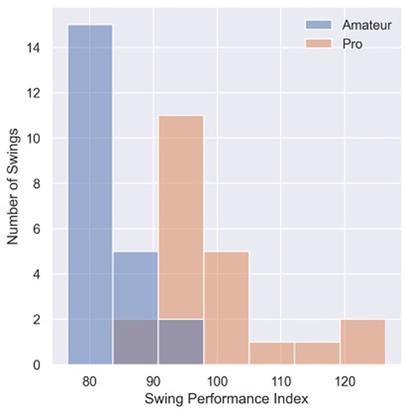- 1Department of Orthopaedic Surgery, Stanford University, Stanford, CA, United States
- 2Motion & Gait Analysis Lab, Lucile Packard Children's Hospital, Palo Alto, CA, United States
Introduction: Golf swing generates power through coordinated rotations of the pelvis and upper torso, which are highly consistent among professionals. Currently, golf performance is graded on handicap, length-of-shot, and clubhead-speed-at-impact. No performance indices are grading the technique of pelvic and torso rotations. As an initial step toward developing a performance index, we collected kinematic metrics of swing rotational biomechanics and hypothesized that a set of these metrics could differentiate between amateur and pro players. The aim of this study was to develop a single-score index of rotational biomechanics based on metrics that are consistent among pros and could be derived in the future using inertial measurement units (IMU).
Methods: Golf swing rotational biomechanics was analyzed using 3D kinematics on eleven professional (age 31.0 ± 5.9 years) and five amateur (age 28.4 ± 6.9 years) golfers. Nine kinematic metrics known to be consistent among professionals and could be obtained using IMUs were selected as candidate variables. Oversampling was used to account for dataset imbalances. All combinations, up to three metrics, were tested for suitability for factor analysis using Kaiser-Meyer-Olkin tests. Principal component analysis was performed, and the logarithm of Euclidean distance of principal components between golf swings and the average pro vector was used to classify pro vs. amateur golf swings employing logistic regression and leave-one-out cross-validation. The area under the receiver operating characteristic curve was used to determine the optimal set of kinematic metrics.
Results: A single-score index calculated using peak pelvic rotational velocity pre-impact, pelvic rotational velocity at impact, and peak upper torso rotational velocity post-impact demonstrated strong predictive performance to differentiate pro (mean ± SD:100 ± 10) vs. amateur (mean ± SD:82 ± 4) golfers with an AUC of 0.97 and a standardized mean difference of 2.12.
Discussion: In this initial analysis, an index derived from peak pelvic rotational velocity pre-impact, pelvic rotational velocity at impact, and peak upper torso rotational velocity post-impact demonstrated strong predictive performance to differentiate pro from amateur golfers. Swing Performance Index was developed using a limited sample size; future research is needed to confirm results. The Swing Performance Index aims to provide quantified feedback on swing technique to improve performance, expedite training, and prevent injuries.
Introduction
Golf is a popular sport with approximately 37 million participants in the United States (1). The modern golf swing is a complex and asymmetrical movement that harnesses body rotational mechanics to optimize driving distance and direction. A successful swing is challenging to achieve, and poor swing dynamics can lead to injury. Performance indices can efficiently provide evaluation, comparison, and outcome assessment, summarizing the quantitative data captured by motion analysis on athletic technique.
With each golf swing lasting just one second on average, it is important to identify swing deficits to provide real-time feedback and quantify adjustments in technique for performance optimization and injury prevention. Professional golf swings involve motions that are smooth, cadenced, and efficient. Peak rotational velocity must be translated through the club while maintaining control and precision. Biomechanical factors influencing golf swing power generation have previously been characterized as pro swing benchmark curves to better understand the differences between amateur and professional golfers (2). Benchmark curves of angle of rotation and rotational velocities of the pelvis, upper torso, and X-prime (defined as the rate of change of the relative angular position between the pelvis and upper torso along the transverse plane) have previously been established throughout the pro golf swing, shown to be consistent in pros, and significantly different between amateurs and professionals (3). Professional golf instructors and several studies (2, 3) have emphasized the importance of absolute and relative pelvic and upper-torso rotation, pelvic rotation, translation, and free moment of force that translates from golfer to ball during the golf swing. Cheetham et al. used wearable sensors and 3D motion analysis to quantify segments of the golf swing and found that the timing sequence of rotational velocity peaks consistently differentiated pro from amateur golfers. Their findings support the proximal to distal sequencing theory first introduced by Cochran and Stobbs in 1968 (4) in that pros have maximum rotational velocity first at pelvis, then thorax, then arm and finally club. In amateurs, they found that the mean arm peak time is before the mean thorax peak time which suggests that amateurs tend to use their arms earlier in the downswing than the pros and had greater variability in their swing sequencing and timing (5). Other studies have also emphasized the importance of proximal to distal body segment sequencing (6) and importance of X-factor timing, specifically that a greater increase in the X-factor early in the downswing correlates with pro golf swing (7). We sought to measure the rotational parameters of the golf swing and elucidate whether single parameters or a combination of parameters in a performance index could differentiate individual golf swings at pro or amateur levels.
In elite athletics, there are ongoing attempts to measure players' games. Various player statistics are used, such as ranking points, money earned, top finishes, and scores. Studies have used earnings (8–12) or scoring average (8, 9, 12, 13) as the dependent variable to examine the relative importance of various parts of the game, such as driving accuracy, greens in regulation, sand saves, and putts per round on athlete performance. Partial scores gather statistics of player history round-by-round, hole-by-hole, or shot-by-shot (14, 15). However, to our knowledge, no index currently summarizes kinematic data from a golf swing into a single score to grade performance.
Performance indices can provide a single score of golf swing technique for evaluation, comparison, and outcome assessment, that summarizes the comprehensive kinematic and temporal-spatial data captured by motion analysis. Several studies have shown that IMUs can be reliably used to identify the various segments of the golf swing (16, 17). It has also been shown that data derived from IMUs have the potential to classify swing technique as proper or improper, where improper swing has a higher likelihood to cause injury (18). Finally, real-time IMU-based analysis of the wrist angle uncocking motion shows the coaching potential of wearable sensors (19). Single-score indices are widely used in gait evaluation to assess walking patterns and are useful in diagnosis and outcome assessment (20–22). To our knowledge, no index has been created that aggregates kinematic measures of the golf swing to grade swing.
Current measures of the golf swing rely on handicap, Clubhead Speed at Impact (CSI), and driving distance. However, none provide direct feedback on rotational technique. Trunk rotation assessed with the upper torso and pelvic rotational velocities, as well as upper torso and pelvic obliquities, are readily measured with kinematic analyses, and deviation from pro swings can provide useful feedback on training progress.
Golf-related injuries commonly occur in the lower back (incidence 15%–36%), shoulders (incidence 6%–10%), wrists (incidence 13%–36%), and elbows (incidence 7%–50%) (23–36). Injury occurs from overuse, primarily in professionals, or trauma and improper swing biomechanics. Improper rotational biomechanics have been shown to increase the torque, shear, and lateral-bending forces experienced by the lumbar spine in professional golfers (37). Another goal of developing a single-score index is to better define optimal swing biomechanical parameters to assist trainees in avoiding motions that may be extreme and ultimately lead to injury.
This research calculates an index of golf swing rotational biomechanics assessed with 3D kinematic metrics. We sought to create a single-score index, the Swing Performance Index (SPI), that could quantify how much an individual golf swing differs from typical pro golf swings using biomechanical parameters that had been found to be consistent in pro golf swings and could be derived using inertial measurement units (2, 3). The SPI seeks to standardize pro golf swings to a score of 100 ± 10 (mean ± SD), with lower values being indicative of suboptimal upper torso and pelvic rotational biomechanics. This index builds upon prior pro swing benchmark analyses throughout the swing phases (Figure 1) (2, 3, 4). In creating the golf SPI, we considered the inclusion of kinematic metrics thought to be technically relevant, reported in the literature, and those that demonstrated statistical significance in differentiating amateurs from pros in our data set.
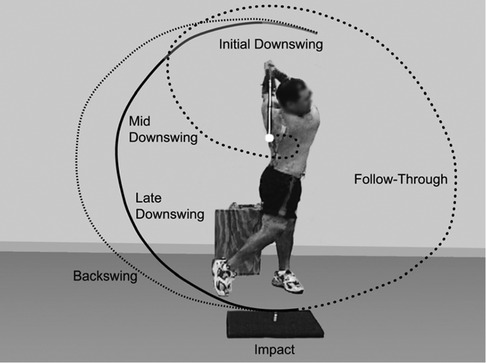
Figure 1. Demonstration of the primary phases of the golf swing as determined by clubhead position: address, backswing, downswing, impact, and follow-through (46).
We hypothesized that the golf SPI will differentiate between amateur and pro golfers.
Methods
Participant recruitment and data collection
Data were included from eleven pros and five amateurs, recorded at the Motion & Gait Analysis Lab at Lucile Packard Children's Hospital at Stanford, CA (2, 3). This study was approved by the Stanford University Institutional Review Board (protocol ID# 11910). Inclusion criteria were amateur or professional male golfers with no musculoskeletal injury that might impact their golf swing. Professional golfers were members of the Professional Golfers' Association (38). To include a range of skill levels for comparison, amateur golfers included one with a low handicap (handicap = 4), one with a medium handicap (handicap = 15), one with a high handicap (handicap = 30), and two novices who did not play regularly (handicap unknown). All participants provided informed consent.
For each subject, a simplified marker set using reflective markers with a diameter of one centimeter was used to evaluate rotational velocities of the pelvis and upper torso. Reflective markers were placed on the anterior superior iliac spines (ASIS) bilaterally to evaluate pelvic motion, and on the acromia bilaterally to evaluate upper torso motion. The orientation of the pelvis and upper torso was determined by subtracting the 3D vectors of the left and right ASIS, and the left and right acromion marker positions, respectively. Rotational velocities were obtained by calculating the rate of change of the pelvic and upper torso orientation along the transverse plane using Python and NumPy (39, 40). A marker was also placed at the distal end of the club shaft at 5 cm from the center of the clubface, and a plastic practice ball was wrapped in reflective tape to identify ball contact and Clubhead Speed at Impact (CSI). An 8-camera motion capture system (Motion Analysis Corporation, Rohnert Park, CA, USA) was used to capture marker positions with a sampling rate of 240 Hz.
All participants were given an opportunity to warm up in the testing area before the swings were recorded. Golfers then performed three hard swings using their own five iron from which the two best swings with minimal marker dropout were analyzed. For pro golfers, both of these two swings were processed. Amateur golfers had less experience controlling their golf swing speed; therefore, only the swing with the highest CSI was processed.
Definitions of the golf swing cycle and kinematic metrics
Each golf swing was analyzed based on the phases of the golf swing cycle (Figure 1). The start of the backswing was determined by the first point in time with a substantial increase in vertical displacement of the clubhead. Based on previous studies and confirmed through visualization of individual golf swings using the motion capture software, a vertical clubhead speed greater than 0.2 m/s after address was found to consistently identify the beginning of each golf swing (2, 3). Impact was defined as the time point immediately preceding the initial increase in ball velocity. The end of follow-through was defined as the first local minimum in vertical clubhead displacement following impact.
Orientation of the upper torso and the pelvis were calculated independently and were obtained by connecting a virtual segment across the acromion markers for the upper torso, and the ASIS markers for the pelvis. Rotational velocities were determined by calculating the rate of change of the orientation of the virtual segments along the transversal plane, measured in degrees per second. X-prime was defined as the difference between the pelvic and upper torso rotational velocity at each time point throughout the swing (2).
Clubhead speed was calculated from the change in position of the marker attached to the distal end of the shaft between impact and the immediate next time point. Since the marker on the distal end of the shaft was located 5 cm from the center of the clubface, we approximated clubhead speed by fitting a circle to the trajectory of the distal shaft in the 50 time points immediately preceding and after impact and adding 5 cm to the radius of the resulting circle.
Data analysis
Nine candidate kinematic metrics (Figure 2) were considered for the construction of the golf SPI, including peak rotational velocity pre-impact, at impact, and post-impact of the pelvis, upper torso, and X-prime. Before performing the index computation, the kinematic metrics were normalized to zero mean and unit variance using the professional group's distribution.
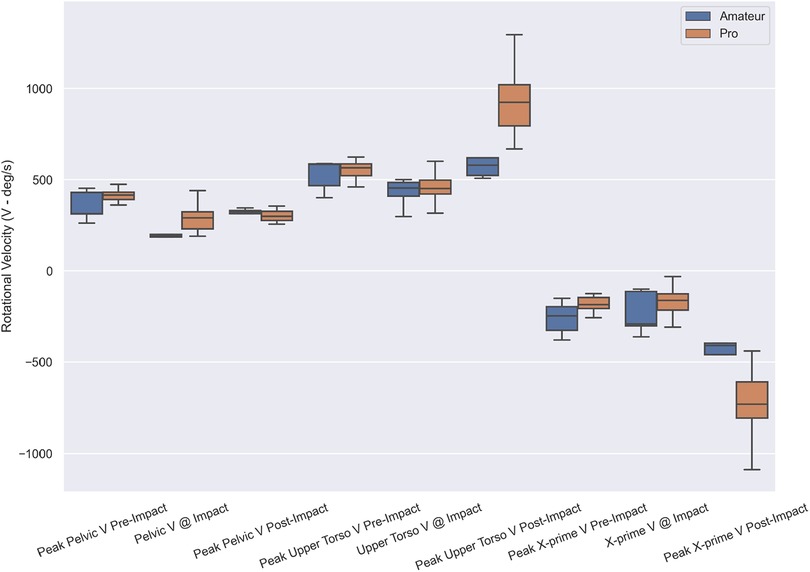
Figure 2. Box plot of individual extracted kinematic metrics of pro vs. amateur golf swings showing the median, minimum, maximum, 25, and 75 percentiles.
All combinations of up to three kinematic metrics were tested using the Kaiser-Meyer-Olkin (KMO) test to determine if the set of variables is suitable for factor analysis (41). KMO values below 0.6 were considered inadequate and were excluded from further analysis. For each combination suitable for factor analysis, a distinct copy of the original dataset containing only the kinematic metrics determined by the combination was used for further processing.
To lower potential bias and better capture differences between the two groups, the dataset of the amateur group was oversampled using the Synthetic Minority Over-sampling Technique (42) to account for imbalance in data containing more than twice the number of participants in the professional over the amateur group. A sample from the amateur group and its nearest neighbor in the feature space was chosen, and a randomly selected point between the two vectors was added to the dataset. This process was repeated until the number of samples in the two groups were equal.
To decouple interrelated parameters into independent components, for each combination, a principal component analysis (PCA) was performed. Principal components of each swing were calculated by applying the PCA transformation to the dataset, using PCA parameters determined by the subset of kinematic metrics of the professional group.
For generating the SPI, the logarithm of the Euclidean distance of the principal components between the swings and the average pro swing vector was calculated. A candidate SPI was calculated by scaling these values so that the mean and standard deviation of the professional golf swings were 100 and 10, respectively.
Each candidate SPI were evaluated using logistic regression with leave-one-out cross-validation to assess their predictive performance in classifying pro vs. amateur swings. The area under the receiver operating characteristic curve (AUC) of the cross-validated model was used to determine the optimal set of kinematic metrics to be used.
Results
Data from eleven pro and five amateur golfers were included in the calculation of the golf SPI (Table 1). The mean age of pro golfers was 31.0 ± 5.9 years, and the mean age of amateur golfers was 28.4 ± 6.9 years (Table 1).
Nine candidate variables were tested, including peak pelvic rotational velocity pre-impact, pelvic rotational velocity at impact, peak pelvic rotational velocity post-impact, peak upper torso rotational velocity pre-impact, upper torso rotational velocity at impact, peak upper torso rotational velocity post-impact, peak X-prime velocity pre-impact, X-prime velocity at impact, and peak X-prime velocity post-impact (Table 2, Figure 2).
A golf SPI calculated using the peak pelvic rotational velocity pre-impact, pelvic rotational velocity at impact, and peak upper torso rotational velocity post-impact demonstrated an optimal set of variables with AUC = 0.97 when pro and amateur swings were classified using logistic regression with leave-one-out cross-validation (Figure 3).
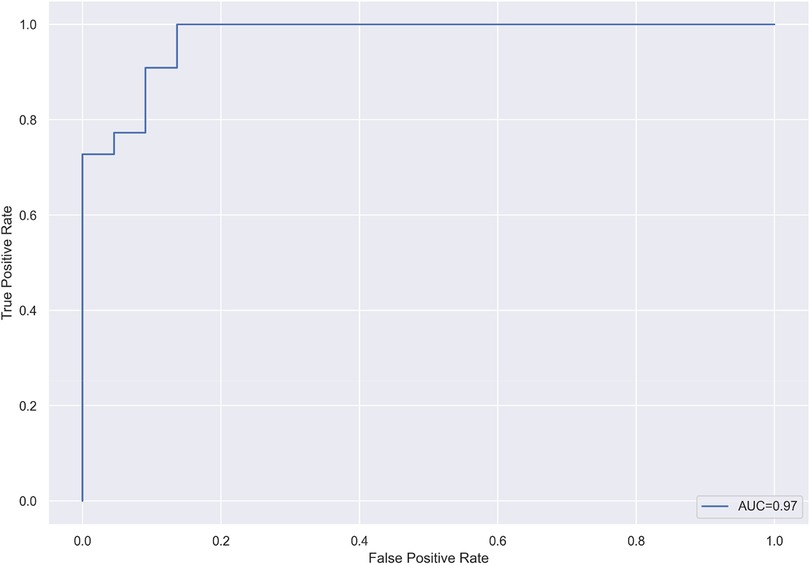
Figure 3. The receiver operating characteristic curve of the cross-validated logistic regression model, differentiating between pro and amateur players, using the swing performance Index based on an optimal set of three kinematic metrics.
Measurement system analysis values of the KMO test for sampling adequacy were 0.76 for peak pelvic rotational velocity pre-impact, 0.60 for pelvic rotational velocity at impact, 0.57 for peak upper torso rotational velocity post-impact, with an overall KMO value of 0.62 that meets the inclusion criteria (>0.6) for factorability (Table 3).

Table 3. Kaiser-Meyer-Olkin (KMO) test for determining suitability for factor analysis of variables selected for inclusion in the swing performance Index.
The mean SPI of pro golfers was 100 ± 10, and the mean SPI of amateur golfers was 82 ± 4 (Table 4 and Figure 4). The standardized mean difference between the two groups was 2.12. The mean SPI of the amateur oversampled dataset was 83 ± 4 (Table 5).
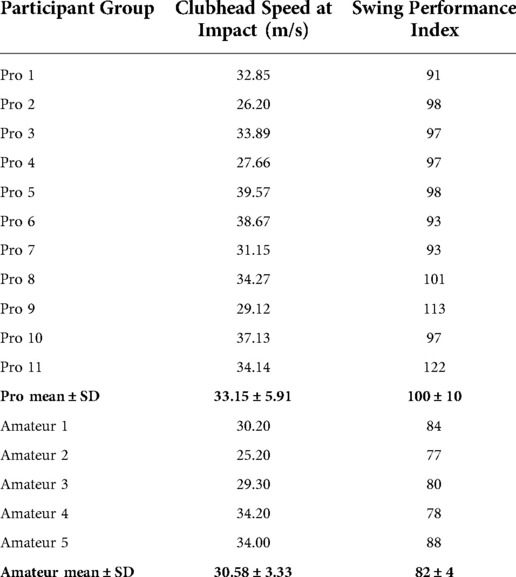
Table 4. Mean values of clubhead speed at impact (CSI) and swing performance Index (SPI) for individual pro and amateur participants.
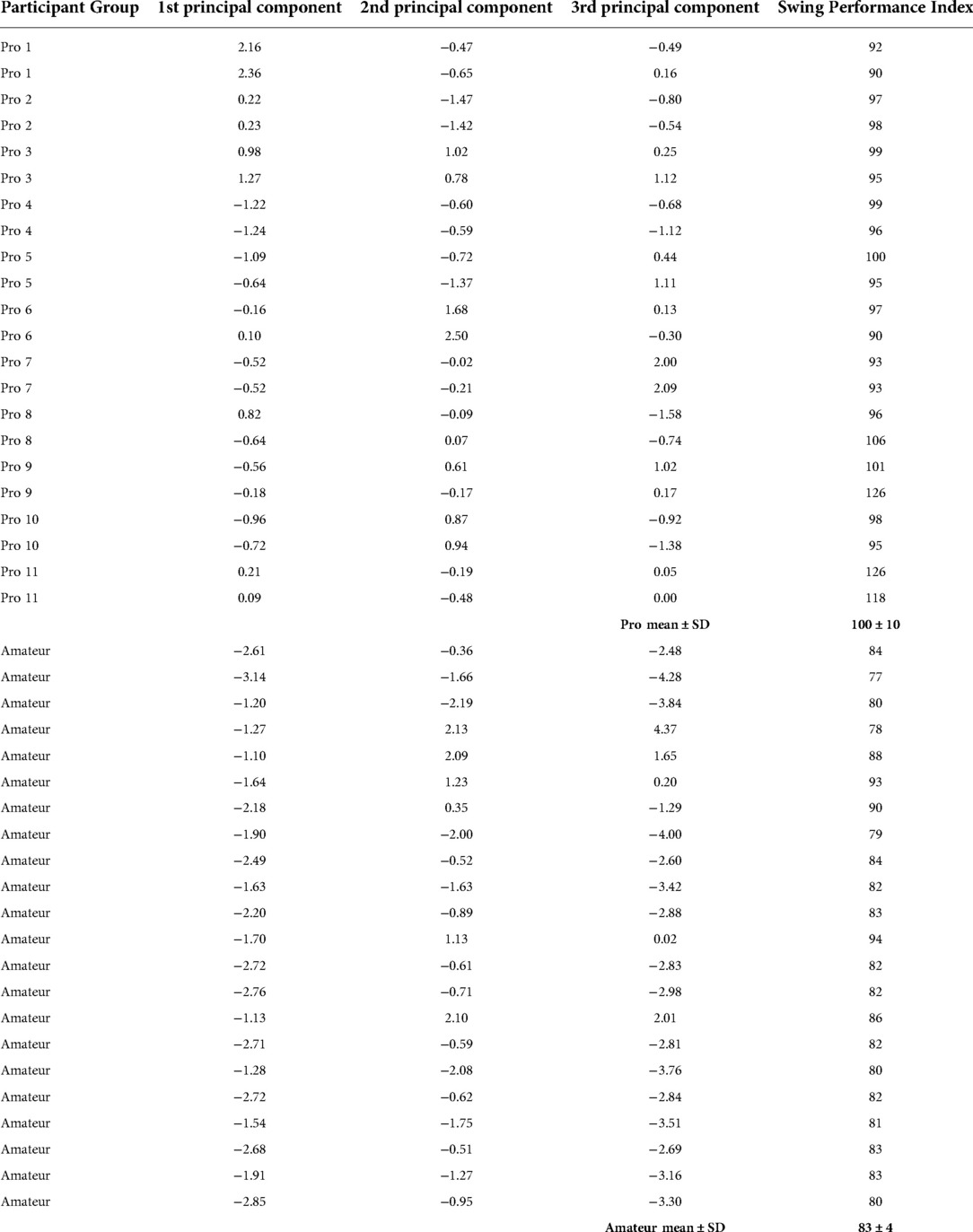
Table 5. Principal components (PC) and swing performance Index (SPI) of individual swing trials. For amateurs, the oversampled data and derived Swing Performance Index are shown.
Among the first 3 best performing models, peak X-prime velocity post-impact was also found to be a major contributor to the predictive model. Figure 5 illustrates the relationship between peak X-prime velocity post-impact and peak upper torso rotational velocity post-impact. This relationship, as well as the separation between professionals and amateurs, highlights the importance of follow-through as an indicator of performance.
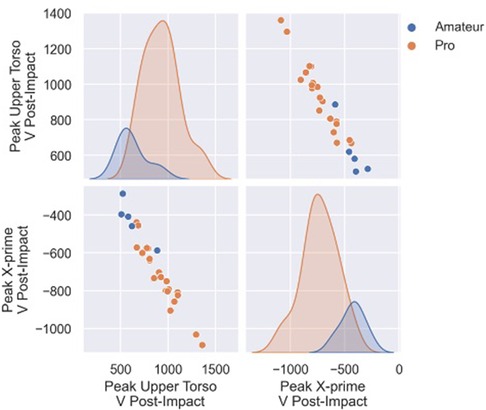
Figure 5. The relationship between peak upper torso rotational velocity post-impact and peak X-prime velocity post-impact, and their distribution in the pro and amateur groups.
Discussion
Golf swing is a movement that generates power through the coordinated rotations of the pelvis and upper torso. Golfers have traditionally relied on handicaps to assess their skill, but the rating system takes many games to calculate and does not provide technical feedback for performance improvement. In addition, CSI and length of shot are commonly used to evaluate golf swings, but neither provide feedback on biomechanical swing technique nor provide feedback for proper rotational biomechanics to minimize injury. Here, we calculated parameters from nine variables narrowed to three rotational metrics to differentiate between pro and amateur swings. We included professional and amateur golfers with a wide variety of experience and training to capture a representative range of swings. The aim of this research is to propose a golf SPI to score golfers on swing technique based on the biomechanical parameters of the upper torso and pelvic rotation that correlate to performance outcomes. A golf SPI using the peak pelvic rotational velocity pre-impact, pelvic rotation at impact, and peak upper torso rotational velocity post-impact demonstrated the highest AUC when pro and amateur swings were classified using logistic regression with cross-validation (Figure 3).
We based our calculation of this index on methods established by prior gait indices in which a standardized population is compared to a separate population to quantify overall differences in parameters with a single outcome (20–22). We created a single-score index for the evaluation of golf swing rotational technique based on biomechanical metrics that had been found to be consistent in professional golf swings. In creating the golf SPI, we considered the inclusion of parameters thought to be technically relevant, reported in the literature, and those that demonstrated statistical significance in differentiating amateurs from pros in our data set. Previous research has shown that although downswing sequence and angular velocity peaks of the body segments may vary with swing style, the backswing and transition sequences are more consistent (5, 43). In addition, certain characteristics, such as a greater increase in the X-factor early in the downswing, are consistently found in pro golfers with high CSI (7). Capturing these defining characteristics can be accomplished by measuring joint angular velocities or joint torques (44). Here, we used 3D motion capture data to evaluate upper torso and pelvic rotational velocities, and to consolidate the defining characteristics of the pro golf swing into a single score, such that amateurs can readily quantify their swing technique as defined by key factors of the pro golf swing.
While this data was collected in a laboratory setting using 3D motion capture, these same metrics can be recorded using lightweight wearable inertial sensors, which currently measure rotational velocities with a low margin of error (45) and will soon offer an inexpensive, easy-to-use option for trainees. Wearable, lightweight inertial measurement unit (IMU) equipped devices open the door to real-time analytics on shoulder (upper torso) and hip (pelvic) rotation during on-the-field training. IMUs have been used with machine learning algorithms to identify specific segments of golf swing (17), recognize swing patterns that can lead to injuries (18), analyze clubhead speed (16), and provide feedback for wrist angles in uncocking motion (19). Integrating IMUs for motion analysis and summarizing the parameters that correlate to pro swing into a single score can assist with providing real-time feedback. This SPI demonstrated a strong association with pro vs. amateur golfers and is intended as an easily administered quantitative metric to augment coaching expertise.
Limitations
In this initial setup, a limited sample size was used to create a continuous score for grading individual golf swings. Future research is needed to validate the SPI against a larger number of participants. Due to the limited number of participants, it is possible that the specific component structure, including the used kinematic metrics and the associated model parameters (i.e., PCA singular values) used to calculate the SPI, would be different in a larger sample. This research utilizes measurements obtained from 3D kinematic motion analysis; future research on rotational biomechanics of the golf swing from IMU-derived data is needed to validate and translate findings to the golf course and driving range.
Implications
The SPI is an objective single-score index of golf swing rotational biomechanics representing golf swing performance compared to benchmark pros. The SPI, constructed from pro and amateur swings, may be a useful tool for detecting swing inefficiency and augmenting coaching, allowing for expedited learning and injury prevention.
Data availability statement
The raw data supporting the conclusions of this article will be made available by the authors, without undue reservation.
Ethics statement
The studies involving human participants were reviewed and approved by Stanford Institutional Review Board. The patients/participants provided their written informed consent to participate in this study.
Author contributions
JZ: contributed to the research design, analysis, and preparation of the manuscript. AR: contributed to the research design, analysis, and preparation of the manuscript. KS: contributed to the research design, analysis, and preparation of the manuscript. AL: contributed to the research design, analysis, and preparation of the manuscript. JR: contributed to the research design, analysis, and preparation of the manuscript. All authors contributed to the article and approved the submitted version.
Acknowledgments
We would like to thank Sung Eun Kim and Deborah Kenney for their helpful discussions.
Conflict of interest
The authors declare that the research was conducted in the absence of any commercial or financial relationships that could be construed as a potential conflict of interest.
Publisher's note
All claims expressed in this article are solely those of the authors and do not necessarily represent those of their affiliated organizations, or those of the publisher, the editors and the reviewers. Any product that may be evaluated in this article, or claim that may be made by its manufacturer, is not guaranteed or endorsed by the publisher.
References
1. Golf Industry Facts. Golf Industry Facts. Available at: https://www.ngf.org/golf-industry-research/#golf-course-supply
2. Meister DW, Ladd AL, Butler EE, Zhao B, Rogers AP, Ray CJ, et al. Rotational biomechanics of the elite golf swing: benchmarks for amateurs. J Appl Biomech. (2011) 27(3):242–51. doi: 10.1123/jab.27.3.242
3. Steele KM, Roh EY, Mahtani G, Meister DW, Ladd AL, Rose J. Golf swing rotational velocity: the essential follow-through. Ann Rehabil Med. (2018) 42(5):713–21. doi: 10.5535/arm.2018.42.5.713
4. (England) GS of GB, Cochran A, Noble D, Stobbs JLN. The search for the perfect swing. By alastair cochran and john stobbs. With assistance from david noble and others, Etc.(An account of the golf society of great britain scientific Study.)[With illustrations.]. Heinemann; 1968.
5. Cheetham PJ, Rose GA, Hinrichs RN, Neal RJ, Mottram RE, Hurrion PD, et al. Comparison of kinematic sequence parameters between amateur and professional golfers. Proceedings of the World Scientific Congress of Golf. (2007) 6:30–6.
6. Neal R, Lumsden R, Holland M, Mason B. Body segment sequencing and timing in golf. Int J Sports Sci Coach. (2007 Jun) 2(1_suppl):25–36. doi: 10.1260/174795407789705497
8. Low Scores, Top 10 Finishes, and Big Money: An Analysis of Professional Golf Association Tour Statistics and How These Relate to Overall Performance—Thomas N. Dorsel, Rob J. Rotunda, 2001. [cited 2022 Oct 21]. Available at: https://journals-sagepub-com.laneproxy.stanford.edu/doi/abs/10.2466/pms.2001.92.2.575
9. Determinants of Success among Professional Golfers: Research Quarterly for Exercise and Sport: Vol 57, No 1. [cited 2022 Oct 21]. Available at: https://www.tandfonline.com/doi/abs/10.1080/02701367.1986.10605389
10. Differences in Shot-Making Skills among High and Low Money Winners on the PGA Tour—George M. Engelhardt, 1997 [Internet]. [cited 2022 Oct 21]. Available at: https://journals-sagepub-com.laneproxy.stanford.edu/doi/abs/10.2466/pms.1997.84.3c.1314
11. “It’s Not How You Drive, it’s How You Arrive”: The Myth—George M. Engelhardt, 1995. [cited 2022 Oct 21]. Available at: https://journals-sagepub-com.laneproxy.stanford.edu/doi/abs/10.2466/pms.1995.80.3c.1135?casa_token=lnln845V070AAAAA:Lql9fwrPI0EjqBeCV6ljszfQqYTETeZkUXPdGBXrMo0SHK-oJIXzW-p5o3gG6UViGS2KdwOCMe2SkA
12. Determinants of PGA Tour Success: An Examination of Relationships among Performance, Scoring, and Earnings—Peter S. Finley, J. Jason Halsey, 2004. [cited 2022 Oct 21]. Available at: https://journals-sagepub-com.laneproxy.stanford.edu/doi/abs/10.2466/pms.98.3.1100-1106
13. Predictability and Stability of Professional Golf Association Tour Statistics—David S. Belkin, Bruce Gansneder, Morris Pickens, Robert J. Rotella, David Striegel, 1994. [cited 2022 Oct 21]. Available at: https://journals-sagepub-com.laneproxy.stanford.edu/doi/abs/10.2466/pms.1994.78.3c.1275?casa_token=xzzaAg-sQH4AAAAA:Zj5fh8pKxLR6OzuTSgTL9N-iKtCMccs0sE_4W1liG0vmmglr6Xb9FvUbu1CHI9r4-Mv4cwuUh2p8MA
14. Larkey PD. Comparing players in professional golf. In: Cochran AJ, Farrally M, editors. Science and golf II. London, UK: Taylor & francis (1994). pp. 257–64.
15. Jiménez JA, Fierro-Hernández C. Are European and American golf players different? Reply to engelhardt (1997). Percept Mot Skills. (1999) 89(2):417–8. doi: 10.2466/pms.1999.89.2.417
16. Lückemann P, Haid DM, Brömel P, Schwanitz S, Maiwald C. Validation of an Inertial Sensor System for Swing Analysis in Golf. In: The 12th Conference of the International Sports Engineering Association. MDPI; 2018 [cited 2022 Oct 16]. p. 246. Available at: https://www.mdpi.com/2504-3900/2/6/246
17. Kim M, Park S. Golf swing segmentation from a single IMU using machine learning. Sensors. (2020) 20(16):4466. doi: 10.3390/s20164466
18. Tangwongcharoen W, Titiroongruang W. Determining golf swing patterns using motion sensors for injury prevention. In Proceedings of The International MultiConference of Engineers and Computer Scientists 2017. 2017 Mar 15. (2017). p. 765–9.
19. Chun S, Kang D, Choi HR, Park A, Lee KK, Kim J. A sensor-aided self coaching model for uncocking improvement in golf swing. Multimed Tools Appl. (2014) 72(1):253–79. doi: 10.1007/s11042-013-1359-2
20. Schwartz MH, Rozumalski A. The gait deviation index: a new comprehensive index of gait pathology. Gait Posture. (2008) 28(3):351–7. doi: 10.1016/j.gaitpost.2008.05.001
21. Cahill-Rowley K, Rose J. Toddle temporal-spatial deviation index: assessment of pediatric gait. Gait Posture. (2016) 49:226–31. doi: 10.1016/j.gaitpost.2016.06.040
22. Zhou JY, Zhang K, Cahill-Rowley K, Lowe E, Rose J. The pediatric temporal-spatial deviation Index: quantifying gait impairment for children with cerebral palsy. Dev Med Child Neurol. (2019) 61(12):1423–31. doi: 10.1111/dmcn.14271
23. McCarroll JR, Gioe TJ. Professional golfers and the price they pay. Phys Sportsmed. (1982) 10(7):64–70. doi: 10.1080/00913847.1982.11947272
24. Jobe FW, Pink M. The Athlete's Shoulder. J Hand Ther. (1994) 7(2):107–10. doi: 10.1016/S0894-1130(12)80079-2
25. McCarroll JR. The frequency of golf injuries. Clin Sports Med. (1996) 15(1):1–7. doi: 10.1016/S0278-5919(20)30154-X
26. Grimshaw P, Giles A, Tong R. Grimmer K. Lower Back and Elbow Injuries in Golf. Sports Med. (2002) 32(10):655–66. doi: 10.2165/00007256-200232100-00004
27. Hovis WD, Dean MT, Mallon WJ, Hawkins RJ. Posterior instability of the shoulder with secondary impingement in elite golfers. Am J Sports Med. (2002) 30(6):886–90. doi: 10.1177/03635465020300062101
28. Lindsay D, Horton J. Comparison of spine motion in elite golfers with and without low back pain. J Sports Sci. (2002) 20(8):599–605. doi: 10.1080/026404102320183158
29. Parziale JR. Healthy swing: a golf rehabilitation model. Am J Phys Med Rehabil. (2002) 81(7):498–501. doi: 10.1097/00002060-200207000-00005
30. Gosheger G, Liem D, Ludwig K, Greshake O, Winkelmann W. Injuries and overuse syndromes in golf. Am J Sports Med. (2003) 31(3):438–43. doi: 10.1177/03635465030310031901
31. McHardy A, Pollard H, Luo K. Golf injuries: a review of the literature. Sports Med. (2006) 36(2):171–87. doi: 10.2165/00007256-200636020-00006
32. Wadsworth LT. When golf hurts: musculoskeletal problems common to golfers. Curr Sports Med Rep. (2007) 6(6):362–5. doi: 10.1007/s11932-007-0052-5
33. Vad VB, Bhat AL, Basrai D, Gebeh A, Aspergren DD, Andrews JR. Low back pain in professional golfers: the role of associated hip and low back range-of-motion deficits. Am J Sports Med. (2004) 32(2):494–7. doi: 10.1177/0363546503261729
34. Parziale JR, Mallon WJ. Golf injuries and rehabilitation. Phys Med Rehabil Clin N Am. (2006) 17(3):589–607. doi: 10.1016/j.pmr.2006.05.002
35. McHardy A, Pollard H, Luo K. One-Year follow-up study on golf injuries in Australian amateur golfers. Am J Sports Med. (2007) 35(8):1354–60. doi: 10.1177/0363546507300188
36. Gluck GS, Bendo JA, Spivak JM. The lumbar spine and low back pain in golf: a literature review of swing biomechanics and injury prevention. Spine J. (2008) 8(5):778–88. doi: 10.1016/j.spinee.2007.07.388
37. Edwards N, Dickin C, Wang H. Low back pain and golf: a review of biomechanical risk factors. Sports Med Health Sci. (2020) 2(1):10–8. doi: 10.1016/j.smhs.2020.03.002
38. PGA of America. [cited 2022 Oct 21]. Available at: https://www.pga.com/
40. Harris CR, Millman KJ, van der Walt SJ, Gommers R, Virtanen P, Cournapeau D, et al. Array programming with NumPy. Nature. (2020) 585(7825):357–62. doi: 10.1038/s41586-020-2649-2
41. Kaiser HF. A second generation little jiffy. Psychometrika. (1970) 35(4):401–15. doi: 10.1007/BF02291817
42. Chawla NV, Bowyer KW, Hall LO. Kegelmeyer WP. SMOTE: Synthetic Minority Over-Sampling Technique. Jair. (2002) 16:321–57. doi: 10.1613/jair.953
43. Han KH, Como C, Kim J, Hung CJ, Hasan M, Kwon YH. Effects of pelvis-shoulders torsional separation style on kinematic sequence in golf driving. Sports Biomechanics. (2019) 18(6):663–85. doi: 10.1080/14763141.2019.1629617
44. Putnam CA. Sequential motions of body segments in striking and throwing skills: descriptions and explanations. J Biomech. (1993) 26:125–35. doi: 10.1016/0021-9290(93)90084-R
45. Walmsley CP, Williams SA, Grisbrook T, Elliott C, Imms C, Campbell A. Measurement of upper limb range of motion using wearable sensors: a systematic review. Sports Med Open. (2018) 4(1):53. doi: 10.1186/s40798-018-0167-7
Keywords: golf swing technique, rotational parameters, wearable sensors, performance index, biomechanics
Citation: Zhou JY, Richards A, Schadl K, Ladd A and Rose J (2022) The swing performance Index: Developing a single-score index of golf swing rotational biomechanics quantified with 3D kinematics. Front. Sports Act. Living 4:986281. doi: 10.3389/fspor.2022.986281
Received: 4 July 2022; Accepted: 30 November 2022;
Published: 23 December 2022.
Edited by:
Howie J. Carson, University of Edinburgh, United KingdomReviewed by:
Marco Ghislieri, Politecnico di Torino, ItalyMarco Caruso, Politecnico di Torino, Italy
Yonghe Liu, University of Texas at Arlington, United States
© 2022 Zhou, Richards, Schadl, Ladd and Rose. This is an open-access article distributed under the terms of the Creative Commons Attribution License (CC BY). The use, distribution or reproduction in other forums is permitted, provided the original author(s) and the copyright owner(s) are credited and that the original publication in this journal is cited, in accordance with accepted academic practice. No use, distribution or reproduction is permitted which does not comply with these terms.
*Correspondence: Jessica Rose SmVzc2ljYS5yb3NlQHN0YW5mb3JkLmVkdQ==
Specialty Section: This article was submitted to Elite Sports and Performance Enhancement, a section of the journal Frontiers in Sports and Active Living
 Joanne Y. Zhou
Joanne Y. Zhou Alexander Richards
Alexander Richards Kornel Schadl
Kornel Schadl Amy Ladd1,2
Amy Ladd1,2 Jessica Rose
Jessica Rose

